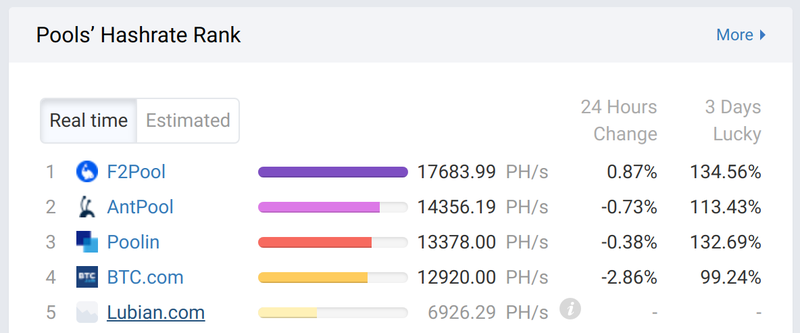Just a day after Bitcoin’s third halving, a new mining pool has burst onto the scene and instantly taken the #5 spot in Bitcoin mining by hashrate.
 (source: BTC.com)
(source: BTC.com)
The pool, known as Lubian.com (links to a Chinese site), is pushing out almost 7,000 petahash/second at the time of writing. The pool’s provenance and identity is unknown online, and the only functional button on the pool’s website leads to a support email amid what is otherwise boilerplate marketing.
Today, a new, mysterious pool with over 6E hashrate just pops up to top 10, right after the halving 🤔🤔
— Dovey 以德服人 Wan 🪐🦖 (@DoveyWan) May 12, 2020
It must be a private pool before now reveals itself to be public as hashrate didn’t see a pop
interesting timing pic.twitter.com/NXoirZe4kt
Crypto industry commentator and founding partner of Primitive Ventures Dovey Wan speculated that Lubian probably owns all its own hardware, as no other hashrate seems to have been poached from competing pools. She considered this an example of the dominance of “whales” (and sharks!) in the Bitcoin mining space. Indeed, ASIC miners are expensive pieces of kit that are usually not economically viable for individuals to run, to say nothing of the technical expertise required to operate.
Whoever owns the pool, must have owns the bootstrapping hashrate to start with as other pools didn’t see a major drop off
— Dovey 以德服人 Wan 🪐🦖 (@DoveyWan) May 12, 2020
5% of total hashrate owned by a single entity, this is how the mining game is heavily skewed towards the mining whale 🐋 or mining shark 🦈
Will dig more
While it has been reported that the pool has existed since late April in a private form, only yesterday (May 12) did it appear on BTC.com as a cohesive mining pool.
CryptoGlobe recently reported that up to 30% of Bitcoin miners could be made redundant on the network following the halving, too inefficient to keep up with miners operating newer machines and thus forced to leave.
Featured Image Credit: Photo via Pixabay.com
 cryptoglobe.com
cryptoglobe.com